Preventing shoulder and rotator cuff injuries through corrective exercise programming (Part 2)
David Cruz, DC, CSCS, FMS, SFMA

Shoulder pain and shoulder injuries related to the rotator cuff are common issues within the general population and among athletes. This article will provide you with background knowledge and practical suggestions on how to prevent or improve conditions of this muscle group through stabilization and strengthening exercises.
In part one we learned that a correct length-tension ratio of the rotator cuff muscles is crucial for shoulder function. If an improper ratio occurs the resulting compensation pattern can lead to secondary latent trigger points, which have the capacity to further alter muscle actions. This was demonstrated by Lucus and colleagues who showed altered muscle activation patterns caused by trigger points led to inefficient muscle function and resulted in early muscle fatigue predisposing the athlete to injury. (1) As indicated in the previous article and in the NASM Essentials of Corrective Exercise Training text, this is one of the primary reasons why self-myofascial release should be integrated into most exercise programs.
Here we’ll discuss stabilizing and strengthening the muscles of the shoulder complex since we now know a few strategies to restore the proper length-tension ratio. When working with an athlete or weekend warrior you will likely find altered motor control if they’ve ever had shoulder pain or an injury even, if they are not currently experiencing pain. This is due to the fact that pain causes a motor response that stimulates certain muscles while inhibiting other ones, which persist even after the pain resolves. (2)
Hodges et al. demonstrated this in the low back showing a delayed contraction of the transverse abdominis and inhibition of the multifidus muscle in patients with a history of low back pain. (3) This delayed muscle activation has also been demonstrated with the peroneal muscle of the ankle, vastus medialis obliquus of the knee and rotator cuff muscles of the shoulder.
David et al. studied the function of the shoulder muscles and showed consistent activation of the rotator cuff muscles prior to superficial deltoid and pectorial muscles with isokinetic rotation. This confirmed the role of the rotator cuff muscles as humeral head stabilizers as they maintain the correct position within the glenoid fossa of the scapula. (4)
In another study Wadsworth et al. found a significant delay in serratus anterior activation in swimmers who were experiencing shoulder pain. The delayed activation of the serratus anterior resulted in their inability to stabilize the scapula against the thoracic wall causing scapular winging or scapular dyskinesia. This led researchers to conclude that the serratus anterior acts as a deep stabilizer similar to that of the rotator cuff muscles. (5)
In the previous article we learned about the concept of relative flexibility, which dictates that movement occurs through the path of least resistance. (6) This results from weak muscles or ones that have a delayed activation pattern requiring synergistic muscles to compensate in order to balance the couple forces that occur with shoulder movement. Therefore proper motor control training is required not only for the rotator cuff muscles but also for the scapular muscles including the serratus anterior and trapezius.
Many exercise protocols tend to place an emphasis on compound movements and load training and do not include enough movements focusing on motor control. But for injury prevention and proper strengthening of the shoulder complex it is important to progress clients appropriately with a multi-phased approach including motor control, isolated strengthening and integrated dynamic movements. (7)
Teaching motor control should include a variety of cues including visual and verbal. (8) No weight should be used at first with the goal of developing perfect movement patterns in flexion, abduction, scapular plane, external and internal range of motion. This will become the baseline of movement to build from. Any alterations of perfect movement such as scapular winging, asymmetrical trapezius activation or compensatory cervical, thoracic or lumbar motion when weight is added would require a regression of less weight, changing to a more stable position or surface, or a combination of all. Although core stability is not the purpose of this article, it should be assessed as a strong core providing proximal stability will allow proper distal mobility and movement patterns of the shoulder.
An easy way for you to assess your clients, as well as teach them proper motor control, is performing shoulder flexion when in a four point kneeling or quadruped position. This will help your client disassociate compensatory movements of the lumbar, thoracic or cervical region. A dowel may also be placed along their spine to cue them to maintain a neutral position. After you have assessed their static scapular position instruct them to activate their core and slowly raise one arm up into flexion while maintaining a neutral scapular position. Compare bilaterally the quality of movement of both the scapula and the humerus.
Four Point Kneeling Shoulder Flexion
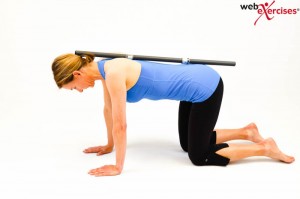
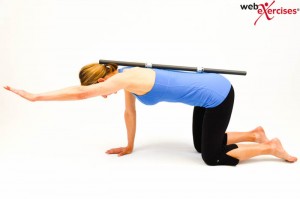
Once your client demonstrates good core control when performing this movement, they may be progressed to a standing position to perform flexion, abduction, scapular plane abduction, internal and external rotation at shoulder level. Initially each movement is trained in isolation with strict attention paid to the quality of movement as progression to weighted exercise is only done when the previous step is mastered.
If clients show signs of “scapular winging” with any of the above movements, weakness of the serratus anterior should be considered. Ludewig and colleague demonstrated progressive EMG activity of the serratus anterior with humeral elevation and upward rotation of the scapula. (9) This lead the authors to conclude that rehabilitation approaches to scapular muscle strengthening should consider the effects of these motions. Therefore the following scapular press exercise will help strengthen the serratus anterior muscles.
Scapular Press with Resistance Band
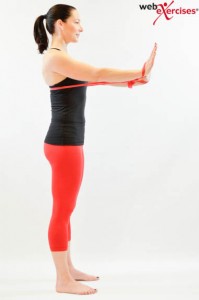
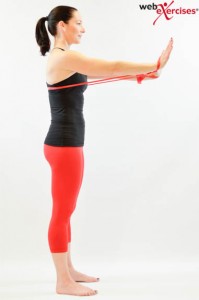
Begin by holding a resistance band so it is wrapped around the mid back. Elbows should be straight. Stand with a neutral scapular position and good upright posture. Extend arms forward by rounding shoulders forward allowing your scapula to spread apart. Slowly return to start position and repeat 3 sets of 10 repetitions.
In addition to the scapular winging the middle trapezius and rhomboids can have an impact on posture: if they are weakened or injured, the muscular tension created by the pectoralis minor will tilt the scapulae forward and down, worsening kyphosis (rounded shoulders).
Blackburn T Scapular Retraction
The Blackburn T is one of the most effective exercises to strengthen weakened posterior deltoid, supraspinatus and trapezius muscles. (10)
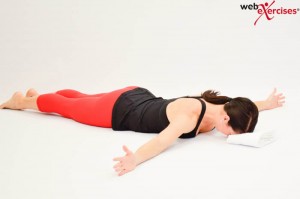
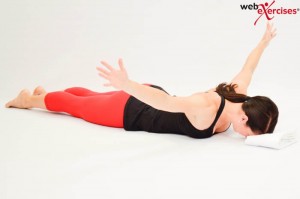
Begin lying face down on the floor or a massage type table. A towel may be placed under the forehead to eliminate cervical extension and activation of the upper trapezius muscles. Arms should be extended to the sides at shoulder level with the hands at 9 and 3 o’clock position. Make the hands into a soft fist with the thumbs up. Lift hands and arms toward ceiling. Then squeeze the shoulder blades together. Neck muscles should remain relaxed. Hold for 5 seconds before returning to starting position. Repeat 3 sets of 10 repetitions.
Once proper motor control has been attained along with scapular stability, rotator cuff strengthening exercises can be integrated. Strengthening the external rotators is important as weakness of the teres minor and infraspinatus is a potential cause for shoulder impingement as well as other conditions. Therefore maintaining an appropriate strength ratio of 66-75% of external to internal strength is critical here (12).
In order to implement a safe strengthening exercise for the external rotator teres minor, perform the following exercise on the floor in the supine position with the arm at shoulder level. This will provide added stability to the shoulder complex allowing your clients to focus on proper motor control and perfect form.
Supine Resisted External Rotation
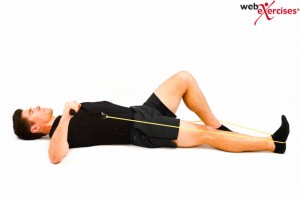
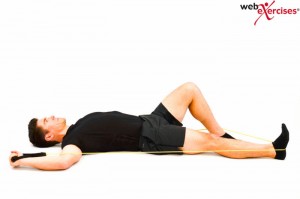
Hold a resistance band on one end while anchoring the other end on one foot. Elevate the elbow to shoulder level, then rotate your hand upward until it touches the floor. Pause momentarily before returning to the starting position. Repeat 3 sets of 10 repetitions.
This exercise should also be performed in the opposite direction with the resistance band anchored above the head in order to work the internal rotator subscapularis muscle.
Once the appropriate strength has been attained in the supine position, you may progress your client allowing them to perform this exercise in a more functional upright position.
Shoulder Level Resisted External Rotation
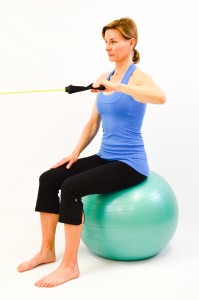
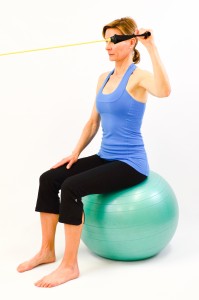
Begin either standing or seated on a stability ball. Hold one end of the resistance band in one hand with elbow out at 90 degrees arm abduction and with the forearm parallel to the floor while the opposite end of the band is anchored at same level in front of the body. While maintaining the same elbow position, rotate the arm upward and backward against the resistance. Pause momentarily and slowly return to the starting position. Repeat 3 sets of 10 repetitions.
Perform this exercise with internal rotation as done previously in the supine version in order to work the subscapularis in a functional position.
Shoulder Level Internal Rotation
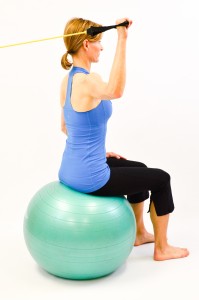
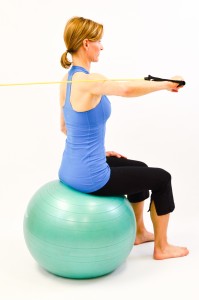
Begin seated on a stability ball. Hold one end of the resistance band in hand with elbow out at 90 degrees arm abduction and with fist up high at full shoulder external rotation while the opposite end of the band is anchored at same level behind the body. Bend the elbow to 90 degrees. Maintaining the same elbow position, rotate the arm, moving the fist forward against resistance. Hold for a couple of seconds and slowly return to starting position. Repeat 3 sets of 10 repetitions.
Once the appropriate strength and stability has been established for the above exercises, a progression which integrates core activation, proprioception and balance may be introduced. An example of this is below with the scapular retraction and external rotator cuff exercises.
Blackburn Y on Stability Ball
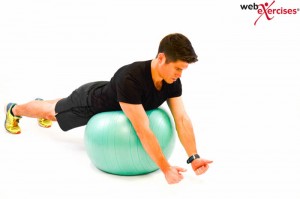
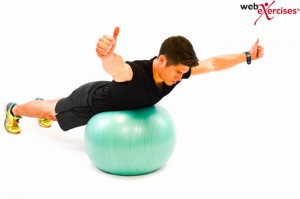
Begin in a plank position on a stability ball. Arms should be extended to sides at shoulder level with hands at 10 and 2 o'clock position. Make hands into a soft fist with thumbs up. Activate core muscles. Lift hands and arms toward ceiling and squeeze shoulder blades together. Neck muscles should remain relaxed. Hold for 5 seconds. Return to start position and repeat 3 sets of 10 repetitions.
Dumbbell External Rotation on Stability Ball
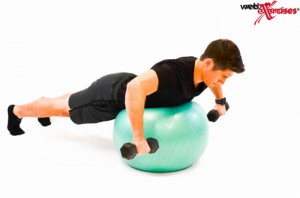
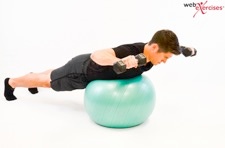
Begin in the plank position on the stability ball while holding dumbbells with elbows at shoulder level and bent to 90 degrees. While maintaining the 90 degree angle at the elbow joint and a stable scapular position, rotate the arms upward until the hand approximately at the level of the ears. Slowly return to start position and repeat 3 sets of 10 repetitions. This is a challenging exercise and can be regressed by using no weights in order to develop the perfect movement pattern.
All of the above displayed exercises are easy to execute and include minimal risks if performed as described. To achieve satisfying results it is important do them on a regular basis and for a minimum of 4 weeks. The general guideline for progressing student athletes is called the “10% rule,” where total training (intensity, frequency, duration, or any combination) is not increased more than a 10% per week. Although there are many approaches to shoulder strengthening hopefully this has provided insight into some basic strengthening strategies. Should your client’s condition become painful or worsen at any time, an evaluation with a medical professional would be warranted.
References
1) Lucas KR, Rich PA, Polus BI. (2010). Muscle activation patterns in the scapular positioning muscles during loaded scapular plane elevation: The effects of Latent Myofascial Trigger Points. Clinical Biomechanics, Oct;25(8):765-70.
2) Nijs J, et al. (2012). Nociception affects motor output: A review on sensory-motor interaction with focus on clinical implications. Clinical Journal of Pain. 175-181.
3) Hodges PW, Richardson CA. (1996). Inefficient muscular stabilization of the lumbar spine associated with low back pain. A motor control evaluation of transversus abdominis. Spine.;21: 2640–2650.
4) Magarey D, et al. (2000). EMG and strength correlates of selected shoulder muscles during rotations of the glenohumeral joint. Journal of Clinical Biomechanics 2: 95–102.
5) Wadsworth DJS, Bullock-Saxton JE. (1997). Recruitment patterns of the scapular rotator muscles in freestyle swimmers with subacromial impingement. International Journal of Sports Medicine 18: 618–624.
6) Sahramann S. (2002) Diagnosis and Treatment of Movement Impairment Syndromes. St. Louis, Mo, USA: Mosby, Inc.
7) Clark M, Lucett S, Sutton B. (2014). NASM Essentials of Corrective Exercise Training. Burlington, MA, USA: Jones & Bartlett Learning.
8) Ro, J, et al. (2008). Effect of motor control and strengthening exercises on shoulder function in persons with impingement syndrome: A single-subject study design. Manual Therapy. 1-9.
9) Ludewig P, et al. (1996). Three dimensional scapular orientation and muscle activity at selected positions of humeral elevation. JOSPT 24(2):57-67.
10) Blackburn TA, McLeod WD, White B. (1990). Electro-myographic analysis of posterior rotator cuff exercises. Journal of Athletic Training. 25:40-45.

